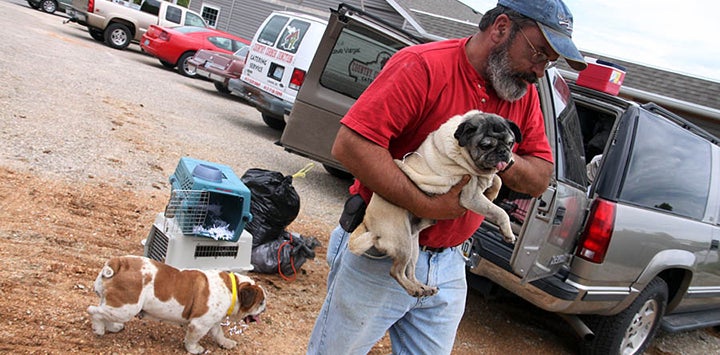
Best Friends Animal Transport Volunteer Playbook
Transport programs play a vital role in lifesaving for many organizations. In this playbook, you will learn the basics of how to get a transport program started, as well as how to recruit volunteers to support this type of program. In addition, you will be provided with sample documents to use in your transport program including: safety protocols, transport log, medical checklist, loading instructions, and more.
Table of Contents
Getting started: Coordinating transports with a receiving agency
Recruiting volunteers for transports
Transport volunteer training and guidelines
Helpful forms and lists
Organizing and loading the transport vehicle
Volunteers on the road
After the transport
Appendix
- Organization Transfer Agreement
- Sample Volunteer Recruitment Email
- Transport Position Descriptions
- Transport Volunteer Training and Safety Documents
- Run Sheet and Transport Log
- Medical Checklist
- Transport Van Loading Checklist
- Transport Volunteer Checklist
- Transport Van Unloading Checklist
Note: This manual was written specifically for use by Best Friends Animal Society. Please feel free to tailor the content to suit your organization's unique requirements.
Getting started: Coordinating transports with a receiving agency
Companion animal transport programs: Best practices
It is incumbent on all organizations to ensure that all stakeholder concerns are adequately monitored and addressed if transfer programs are to be a widely accepted tool in our effort to find homes for all healthy and treatable animals. We encourage collaboration among all stakeholders to provide input for our efforts to promote the best practices which will ensure the safe and effective transfer of animals between organizations.
Finding the right partner
Philosophically, participating agencies must weigh the implications of animal transport carefully and find the right balance for their organization and community. Some of the key questions to be answered are:
- Does transporting animals into a community consume resources which could be used to home local animals with special needs?
- Does the potential to save more lives take precedence over local animal placement?
- What programs are provided to help source communities break the cycle of homeless pets?
- Can broadening the mix of available animals bring more adopters to the shelter?
- Does a transport program provide a greater opportunity to educate both source and destination communities of the need for caring homes?
- What role can transport play for cats?
- What obligation does the receiving agency have in assuring that the root causes of homeless pets are being adequately addressed in the source community?
- Should transport partners be local, regional or long-distance?
Clearly, this is much more than just supply and demand. Shelter resources, community attitudes and the humane mission of participants all impact the decision to establish transfer programs. Ultimately we all strive to show that every life has meaning and value.
Transport guidelines and best practices
Many of the guidelines you read here were gleaned from the Best Practices Committee of the National Federation of Humane Societies (NFHS). The committee included state veterinarians, source and destination agencies and third party facilitators in their information gathering.
In all transport programs there are several key components that must drive all decisions relating to transfers. These are:
- Public health and safety must be the primary concern.
- All transfer agencies must be registered 501(c)(3) agencies or be a municipal agency dealing with animal control.
- All participants must be committed to abiding by all local, state and federal regulations.
- Humane standards of care must be afforded to every animal being transported.
General requirements for source (pulling) and destination (receiving) shelters:
- Source and destination agencies should establish a solid working relationship, both for philosophical alignment and ongoing communication. The agencies should have general agreement about the types of medical and behavioral evaluations that are important to each organization.
- Sourcing and receiving agencies must have 501(c)(3) or pending status, or be a municipal agency dealing with animal control.
- Throughout the process, effort should be made to enhance source agency standards. In particular, the receiving and source agencies should work together to create a plan for addressing the homeless pet issue in the community of origin. Ultimately, the source agency should benefit from the transport partnership.
- The receiving shelter must:
- Have a community demand of adopters for animals being transported
- Not euthanize animals of the species being transferred for time or space
- Have a strong infrastructure to receive large groups of animals
- There should be a designated coordinator at both ends of the transport. This is essential. The role of the coordinator is to:
- Organize timing, number, and types of animals being transported
- Evaluate any health or behavior considerations
- Maintain good communication between the agencies
- Prior to each transport, develop a transport census:
- Source agency should share lists (run sheet) with photographs of animals being considered for transport. It’s best to also provide a bio and medical records for each animal to the receiving agency ahead of time.
- When the final transport list is generated, medical records for each animal should include physical description, intake date, reason for surrender, health and behavior status, and any other available information.
- Transport coordinators should develop a mutually acceptable protocol and time-frame for approving the animals who will be transported.
- All animals scheduled for interstate transport must travel with a valid health certificate, vaccination records, health & behavior records and be transported in accordance with all local, state and federal laws.
- Sick animals are not eligible for transport.
- Each animal should be treated with dignity and respect throughout the process.
Land transport
The following transport guidelines are recommended for land transport:
- Transport vehicles must be cleaned and sanitized to industry standards prior to transport.
- Proper climate control must be maintained. The vehicle must be able to provide heat and/or air conditioning to the animal housing areas and there must be sufficient air ventilation.
- Temperatures should not fall below 60° F or above 85° F. Thermometer must be placed in an area where kennels are located and be easily visible.
- Animals should be transported in separate enclosures (except in the case of litters) with solid, leak-proof bottoms and adequate bedding. Animals should be able to comfortably stand up, lie down and turn around.
- Ensure access to fresh water for every animal at breaks.
- At a minimum, stop every 4-6 hours in a safe area to perform a visual check and to provide more water to the animals.
- Young animals should be fed a small meal or snack every 4-6 hours.
- All trips should be made with a minimum of two drivers and sufficient personnel to appropriately handle and care for all animals.
- Driver and staff safety is of utmost concern. Drivers should travel with cell phones, maps, preferably GPS and emergency equipment.
- The organizations should have an agreed-upon contingency plan to address weather, mechanical or other unexpected situations that may go awry during the transport.
- There must be appropriate identification on each animal and his/her carrier during transport.
Basic, minimum standards for transporting animals in a healthy and safe manner:
- Public health is of primary concern in transport programs. The following medical considerations should be in place prior to transport; vaccines should be done on intake and in compliance with appropriate vaccine handling protocols.
- Rabies vaccinations should be administered by a licensed veterinarian for all animals 16 weeks or older, or in compliance with state standards for the source agency, unless contraindicated for health reasons.
- Conduct a visual exam to rule out the existence of bite wounds, open sores/wounds, runny eyes or runny nose, kennel cough, diarrhea, dermatitis or lethargy.
- If an animal has recently been spayed or neutered, there has been other surgery, or he/she is recuperating from other medical treatment, the animal should have at least 48 hours of recovery time before transport. Surgery other than spay/neuter is not recommended prior to transport.
- Each animal has a valid health certificate signed by a licensed veterinarian. Some states require health certificates signed by a USDA licensed veterinarian. Please check with your local area & state for guidance.
- Young animals should be at least eight weeks old at time of transport unless they are being sent with their mother.
- Each animal should pass the minimum behavior requirements; transported animals should not exhibit aggression.
- All animals must be identified with a tape collar or other tag at the source shelter, prior to transport. An ID must also be included on the transport carrier for each animal.
- Records must be shipped with the animals. These should be kept together in a plastic or other waterproof sleeve, prior to transport. Records should include:
- Health certificate
- Intake form including vaccinations
- All medical & behavioral records
- All animals must be sterilized either by the source agency if possible or by the destination agency prior to adoption.
Finally, a plan for each transport will be discussed, including a date and time for transport and the approximate number of animals.
An Organization Transfer Agreement will be completed and signed by both parties prior to initiating any transports. This agreement will stipulate all requirements by both the source and receiving agencies.
Regulations for companion animal transport are always subject to change. Please consult with local authorities before adopting or implementing any policy or practice to avoid noncompliance with local, state or federal statutes that may apply to your organization.
Recruiting volunteers for transports
Whether your organization has ten volunteers or 10,000, the basics of volunteer recruitment and engagement are the same. The following guidelines are designed to help you recruit, engage and retain exceptional volunteers who will help achieve the transport goals and objectives of your organization.
Assess your organizational needs
You’ll need answers to these questions:
- Do you have enough staff to transport animals routinely and safely to a receiving agency? If not, how many volunteers will you need for ongoing transports?
- What specific tasks need to be completed for these transports?
- Does the receiving agency require temporary foster care for young kittens?
Create transport position descriptions
Creating position descriptions is a great way to clarify your needs and tasks, as well as your expectations for volunteers. Position descriptions also provide a sense of legitimacy to the organization and demonstrate to volunteers that the work they’re performing is necessary and valuable. See the appendix for some sample transport position descriptions.
Create key written materials
In addition to a volunteer agreement form and a volunteer handbook, you should have transport training documents, which set expectations, policies and procedures for transport volunteers. For help writing your own training documents, check out the documents currently used by other trusted organizations. And make sure you regularly revisit these documents as your organization and transport needs grow and change.
Recruit volunteers
Your organization should always be proactive in the recruitment of transport volunteers. You can recruit volunteers in a number of ways, such as through social media, at events and by email. You can view a sample recruitment email in the appendix.
Once you’ve recruited potential candidates, take the time to formally interview them. Doing so demonstrates to them that they’re joining a professional organization, and it gives you the opportunity to find out where they might fit best in helping your organization achieve its transport goals. Be sure to ask thoughtful questions and let prospective volunteers do most of the talking.
Transport volunteer training and guidelines
Provide formal training and safety guidelines
Be sure to offer formal transport-specific volunteer training to provide a safe experience for both your volunteers and the animals they’re transporting. Training is also the appropriate time to have volunteers sign a safety training acknowledgment form. Investing time in training helps ensure that transport best practices are followed and better prepares volunteers for long-term success with your organization. See the appendix for sample safety guidelines from Best Friends for reference.
Track transport volunteer hours
Volunteer time is valuable, not just to you but also to your donors. Accurate tracking of volunteer hours is a key measurement of organizational effectiveness and is required for many grants and other funding sources. Whether you use an electronic method, such as a web-based program or spreadsheet, or just a basic paper sign-in form, keeping an accurate record of all volunteer hours and activities is critical for measuring performance and growing your organization.
Manage volunteer performance
Managing their performance also helps volunteers to succeed. Be sure to set realistic expectations for individual volunteers and make sure they have the support and tools available to perform their responsibilities to the best of their abilities. And be prepared to have constructive, non-confrontational conversations when problems arise or when there’s a need for improvement.
Helpful forms and lists
One week before transport, the source agency should send a list (called a “run sheet”) of animals being transported to the receiving agency. All transported animals should meet the established criteria agreed upon in the Organization Transfer Agreement. The run sheet should include a photo of each animal, along with his/her name, gender, date of birth, ID number and comments.
It is also helpful to have a transport log that volunteers can use to keep track of animals on the run sheet as they are loaded on and off the transport vehicle. This ensures that the right animals get on the right van, with the right medical paperwork. See the appendix for examples of the run sheet and transport log that Best Friends uses.
Receiving agencies require specific medical criteria to be completed for each animal prior to transport. These medical requirements will vary from one agency to another. Using a medical checklist for each animal just before loading and transporting will guarantee that you’ve met the receiving agency’s requests. A sample medical checklist is in the appendix.
Finally, we strongly recommend creating an emergency contact list for volunteers to have on hand while transporting animals. This list should include contacts from both the source and receiving agencies, to cope with problems that might arise getting to and from both locations. If volunteers will be transporting animals long-distance, it’s a good idea to include contacts for towing, auto repair, veterinarians, kennels or boarding, and overnight lodging every two to three hours along the designated route.
Organizing and loading the transport vehicle
Organizing the vehicle
You’ll want to develop a consistent system for loading animals on and off the transport vehicle. The photos below show how Best Friends’ adoption team sets up the van for larger long-distance transports.
Photo # 1: Ford E350 van with 2 single front seats 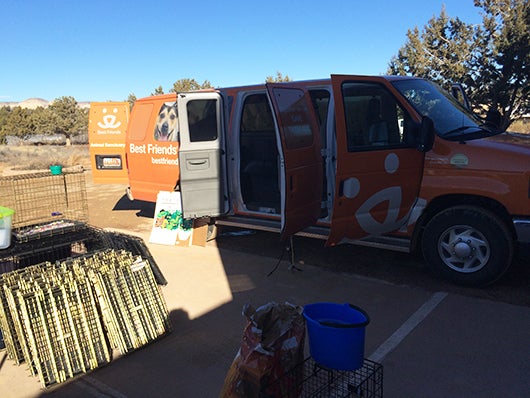
Van can accommodate 30 kennels/cats or 60 kittens for transport (2 per kennel)
Photo # 2: 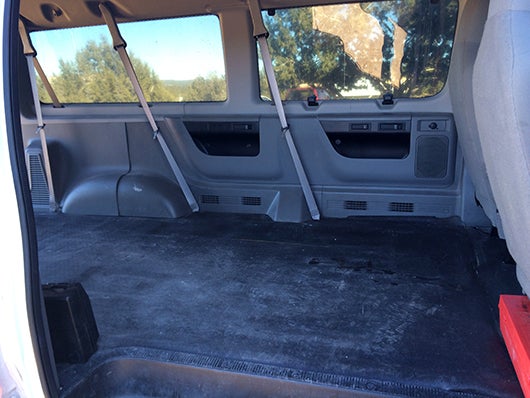
View from side of the van
Photo # 3: 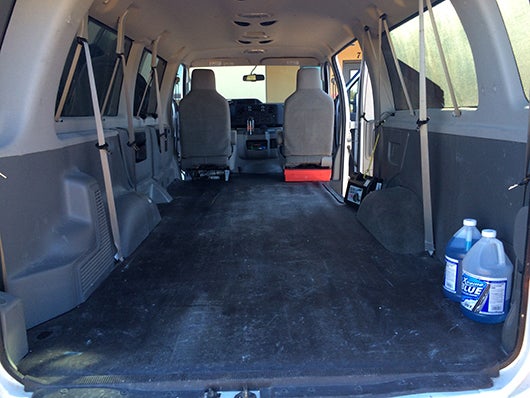
View from back of the van
Photo # 4: 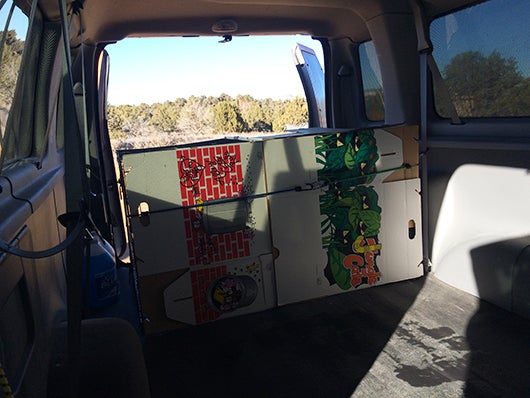
Build barrier wall for kennels in back of the van
Photo # 5: (for transporting dogs or multiple kittens): 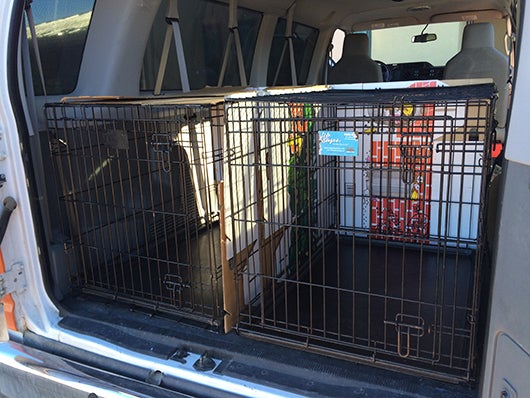
This set up is configured to transport two dogs. If only transporting cats, build two stacked rows of 3 kennels in each row.
Photo # 6: 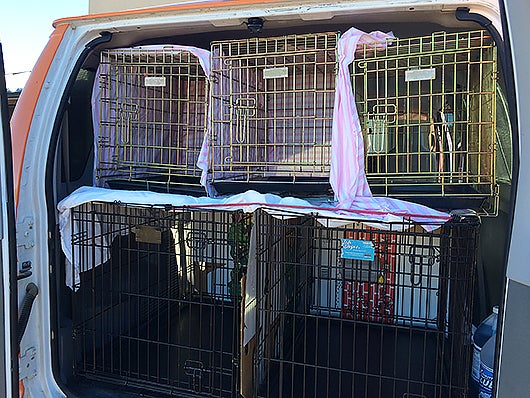
2 dogs for bottom kennels, with 3 cats on top
Photo # 7: 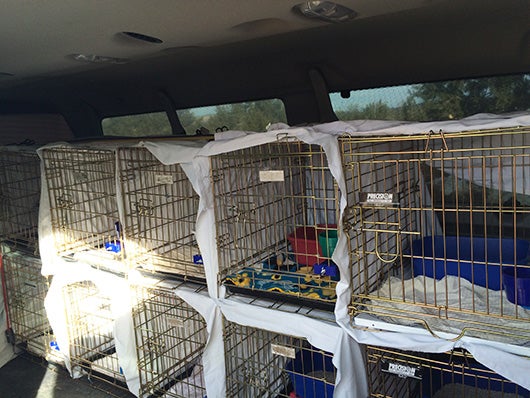
Build two walls of 12 crates each, making sure to cover each kennel for privacy, yet allowing for sufficient air flow. Secure with bungee cords.
Photos #8-9: 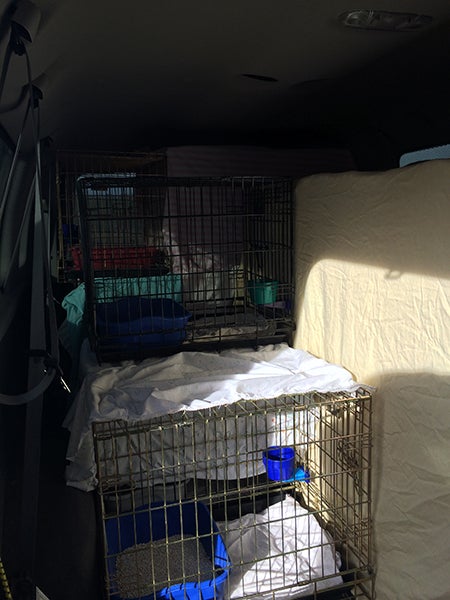
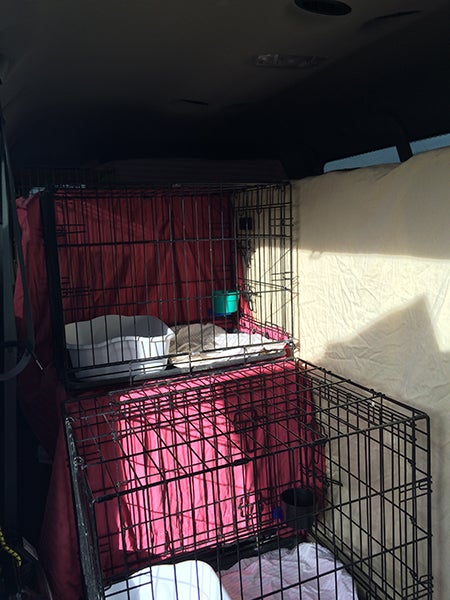
Provide newspaper, litter box, food/water bowls, and sheet in each kennel
All photos courtesy of Larry Erdman
Before leaving, ensure that each kennel is secured and won’t tip over or fall during transport. Bungee cords can be used to secure multiple kennels. Cover each kennel with a sheet to prevent the animals from seeing each other, which helps keep them calm. It’s a good idea to use zip ties or a carabiner as additional protection to keep kennel doors securely locked during transport.
Loading the vehicle
If volunteers will be assisting with loading and unloading your transport vehicle, it’s important for them to understand your system. Providing them with a checklist, like the one in the appendix, will keep them engaged and help the transport run more smoothly.
Volunteers on the road
There should always be two volunteer drivers for interstate or longer distance transports, so they can take turns driving every four to five hours. This will coincide with refueling stops, and give each driver a chance to rest.
All volunteer drivers should have a current and valid driver’s license and personal auto insurance, and must be able to drive safely in all types of weather conditions. If volunteers are driving a vehicle that belongs to your organization, it’s a good idea to have them added to your insurance, and have a roadside assistance plan for that vehicle.
Just before departure, volunteer drivers should double-check to make sure they have everything needed for the trip. An example of a transport checklist, which you can provide volunteers, is in the appendix.
Keep the emergency contact list and transport log in the van at all times. For longer distance transports, coordinate overnight lodging for your volunteer drivers. Before they leave, give them their reservation information and driving directions from the receiving agency to the hotel.
Let your volunteer drivers know they can call you at any time during the transport. Ask them to check in with you periodically during the trip to guarantee their safety and the animals they’re transporting. Once they’ve arrived at the receiving agency, have them call you to let you know that everyone made it there safe and sound.
After the transport
You’ll want to have a system for unloading the vehicle once the transport is complete. The unloading checklist in the appendix will help you make sure that all transport supplies are sanitized properly and returned to the source agency.
Within a week of the transport, follow up with your volunteers for their feedback and suggestions. This is an excellent time to evaluate your process, with the goal of improving it. It’s also the appropriate time to thank volunteers for their hard work, and offer them constructive feedback, if needed.
Finally, be sure to follow up with the receiving agency about the animals they received. Did the animals meet all the required medical criteria? Did the animals look healthy and alert when they arrived? Does the agency staff have any suggestions for future transports?
For additional resources on transporting animals, please check out “Pet Transport Resources” on the Best Friends website at https://resources.bestfriends.org/shelter-rescue-work/help-organizations.
Appendix
Please note: Forms and lists like the ones on the following pages are always being changed and updated. For that reason, it’s best to create online documents, which allow for frequent revisions and updates.
Organization Transfer Agreement
Organization name__________________________________________________________
Contact person________________________________ Position_______________________
Organization’s tax ID number______________________________
Phone________________________________ Cell phone____________________________
Fax___________________________________
Email__________________________________ Website_____________________________
Address_____________________________________________________________________
City____________________________ State___________________ Zip__________________
This is an agreement between Best Friends Animal Society–Los Angeles and its founders, directors, officers, employees, agents, representatives, volunteers, successors, and assigns (called “Best Friends” in this agreement) and _________________________________ and its founders, directors, officers, employees, agents, representatives, successors, and assigns (called “Group” in this agreement) for the transfer to the Group of ownership and care of the dogs identified or to be identified in a separate document.
This agreement includes a release and indemnity agreement.
The Group and Best Friends, in consideration of the mutual promises in this agreement and other good and valuable consideration, intending to be legally bound by this agreement, agree to the following:
Best Friends transfers to the Group the ownership of the dogs identified or to be identified by name, gender, description, and microchip number. Best Friends will transport the dogs to _________________________.
Identification and Licenses. The animal(s) are microchipped for identification. The Group agrees to obtain the proper licenses required by law and also to require all persons with whom it has placed any of the dogs to obtain the proper licenses.
Veterinary Care. The Group agrees to obtain immediate veterinary care should the dog(s) become sick or injured and to take full financial responsibility for such veterinary expenses. The Group agrees to cover all routine expenses associated with the care of the animal(s). If the Group is unable to pay the cost of non-routine treatment, the Group will contact Best Friends and consult with Best Friends about the treatment before any final treatment decisions are made about the care of the animal(s). Best Friends will consider paying for the cost of medical care on a case-by-case basis.
Care of the Animal(s). The Group understands that the animal(s) being transferred under this agreement were rescued from a situation of abuse and neglect. These animal(s) may have medical and behavior problems and may require veterinary care and treatment. The Group agrees to keep the animal(s) indoors or in an enclosed area that will protect the animal(s) from roaming free outdoors and otherwise protect the animal(s) from predators and the weather (including, but not limited to, rain, snow, hail, sleet, temperatures below 40 degrees Fahrenheit and above 85 degrees Fahrenheit). The Group will not tie or chain the animal(s) at any time and shall keep them in a clean, sanitary enclosure free of waste, trash and debris. The Group shall provide nutritious food in sufficient quantities for each dog’s age and size and continuous access to potable water.
The Group shall require all persons with whom it places the dogs to provide care for the animals as set forth in this agreement and provide all appropriate vaccinations.
The Group represents that it is not violating the tenets of any lease, condominium association rules, covenants, etc., and that it is legal for the Group to keep the animal(s) on the Group’s property.
No Representations. The Group understands that Best Friends does not guarantee the health, temperament, or training of any of the animals. The Group understands that some or all of the dogs may have illnesses or diseases, which may require isolation of the dogs from other animals and other special care and treatment.
Release and Indemnity Agreement. The Group, and for its successors and assigns, agrees never to bring a claim against and releases and forever discharges Best Friends and their successors and assigns from all liability arising from any activity associated with the transfer of ownership, transport, care and adoption of the animal(s) or any other work or activity of the Group.
The Group understands that this agreement releases and forever discharges Best Friends from any liability to the Group and its successors and assigns with respect to bodily injury, personal injury, illness, death, property damage or other loss that may happen as a result of any activity associated with the transfer of ownership, transport, care and adoption of the animal(s) or any other work or activity of the Group.
Indemnity Agreement. The Group agrees to indemnify and hold Best Friends harmless for all bodily injury, personal injury, illness, death, property damage or other losses, including attorney’s fees and costs of litigation, that result to anyone else or any other entity because of the Group’s negligence or liability. This includes lone acts by the Group as well as the combined acts of the Group with others.
Assumption of the Risk. The Group understands that the transfer of ownership, transport, care and adoption of the animal(s) may include activities that may be hazardous to the Group or its founders, directors, employees, agents, representatives, volunteers, successors and assigns. This includes, but is not limited to, being around animals that may bite, scratch or cause disease or illness and providing shelter and other care for them. The Group understands that activities associated with the transfer of ownership, transport, care and adoption of the animal(s) may, in some situations, involve inherently dangerous activities.
The Group expressly assumes the risk of injury, harm or death in these activities and releases and forever discharges Best Friends from all liability for injury, illness, death, property damage or other loss resulting from the transfer of ownership, transport, care and adoption of the animal(s) or any other work or activity of the Group.
Site Check. By signing this agreement, the Group consents to allow Best Friends to do a site check prior to taking the animal(s).
Change of Address. In the event that the Group moves, it agrees to contact Best Friends with change of address information, so that all records can be updated and microchip information can be changed. Upon request by Best Friends, the Group agrees to provide Best Friends with change of address information for all persons with whom any of the dogs are placed, to the extent known.
The Group understands and agrees that Best Friends does not allow or agree to the euthanization of the animal(s) under any circumstances except in the case of suffering that cannot be relieved. The Group agrees not to euthanize or arrange for the euthanization of any of the dogs under any circumstances without the express written consent of Best Friends.
Any breach of this agreement by the Group is material.
The Group represents and warrants that the information provided in the Organization Adoption Application is true and correct and that Best Friends has reasonably relied on that information in entering into this agreement.
THIS AGREEMENT is the entire agreement between Best Friends and the Group and supersedes any prior writings, discussions or understandings between the parties with respect to the subject matter of this agreement. No modification of this agreement will be valid unless it is in writing and duly signed by Best Friends and the Group. This agreement is binding upon the heirs, assigns, successors, personal representatives and executors of both parties. This agreement shall be governed by and interpreted in accordance with the laws of the State of Utah. The parties agree that in the event that any clause or provision of this agreement shall be held to be invalid by any court of competent jurisdiction, the invalidity of such clause or provision shall not otherwise affect the remaining provisions of this agreement. By signing below, the parties each represent that they have read this agreement and fully understand it contains a release and indemnity agreement and that they have each had a chance to obtain legal advice about the agreement. The parties further represent that they are of legal age and legally competent to execute this agreement and that they do so of their own free will and that they have not relied on any representation of any kind or character not contained in this agreement.
By signing below, the parties acknowledge they have read and understand the terms of this agreement.
Group representative:
______________________________________________ Date_______________________
Best Friends Animal Society representative:
______________________________________________ Date_______________________
Sample Volunteer Recruitment Email
Email Subject: Best Friends volunteers needed to help transport cats & kittens!
[Header:] Best Friends volunteers needed to help transport animals from the Sanctuary to the Pacific Northwest
Help save the lives of cats & kittens in Southern Utah ! Best Friends Animal Society, CAT Adoption Team, and Ben Franklin Humane Society are partnering to transport adoptable cats in Southern Utah to find their forever homes. Volunteers are needed to help with transports from the Sanctuary to Oregon and/or Washington state. The transport van, lodging, and meals are provided.
This is a huge lifesaving effort – the goal for 2016 is to transport 200 healthy cats and kittens to loving homes in the Pacific Northwest!
Volunteers must be at least 23 years of age to volunteer for this opportunity.
For more information about this volunteer position, click here.
Please email nationalvolunteers@bestfriends.org to sign up or for more information.
Thank you for being a part of this important project. Together, we can Save Them All®.
If you would no longer like to receive notification of Best Friends volunteer opportunities please
email nationalvolunteers@bestfriends.org & we will promptly remove you from our list.
Transport Position Descriptions
Sample position 1
Name of Position: Transport Volunteer
Division: Volunteer & Visitor Experience
Reports to: National Volunteer Program Coordinator
Function/Impact:
A team of two volunteers will pick up healthy, adoptable cats from the source agency, and transport them overnight to the receiving agency for adoption. The volunteers will drive the van back to the source agency at the end of the transport trip. These efforts will result in homes for 250 cats this year.
Time Commitment and Location of Work:
- Transports occur once per month, year round
- Three days of travel time, round trip
- Leave the source agency for transport between 2 and 4 p.m.
- Arrive at the receiving agency the following morning, between 8 and 10 a.m., approximately 16 hours of driving overnight
Core Responsibilities:
- Safely and successfully drive the transport van (alternating every few hours with the other volunteer) from the source agency in Las Vegas to the receiving agency in Portland, Oregon
- Assist with unloading of all cats and paperwork from the van upon arrival at the receiving agency
- Once unloading is finished, rest the second day in Portland (lodging provided)
- On the third day, drive the empty van back to the source agency
- Track and input total transport hours worked into the volunteer database
Qualifications/Requirements:
- Successful completion of transport volunteer safety training
- Must be at least 21 years of age with satisfactory driving record
- Proof of valid/current driver’s license and insurance
- Must be able to safely drive and work in all weather conditions
- Must be able to bend, stoop, hike, walk, kneel and lift
- Must be able to lift at least 30 pounds at a time
- Cat-handling experience is a plus
Sample position 2
Name of Position: Transport Loader/Unloader Volunteer
Division: Volunteer & Visitor Experience
Reports to: National Volunteer Program Coordinator
Function/Impact:
The volunteer will work with the volunteer coordinator and animal relocation and transfer coordinator to prepare the van before and/or after transport to the receiving agency in Portland, Oregon. These efforts will result in homes for 250 cats this year.
Time Commitment and Location of Work:
- Loading shift: One weekday afternoon per month, 12 hours (will vary)
- Unloading shift: One weekday morning per month, 12 hours (will vary)
Core Responsibilities:
Loaders:
- Set up and prepare cat carriers for the transport van
- Remove cats/kittens from their kennels
- Confirm with Best Friends staff conducting medical checks that all requirements for each cat are met
- Once medically cleared, place cats/kittens in kennels in the transport vehicle
- Ensure that all appropriate paperwork for each animal is completed and in the vehicle
- Report any issues immediately to the national volunteer program coordinator
- Track and input hours worked into the volunteer database
Unloaders:
- Remove empty cat kennels from the van
- Ensure that all necessary transport paperwork is given to the animal relocation and transfer coordinator
- Unload and restock supplies
- Clean out and sanitize the van
- Track and input hours worked into the volunteer database
Qualifications/Requirements:
- Ability to work in a fast-paced environment
- Report at Best Friends on time for loading and unloading of the van
- Must be able to lift at least 30 pounds
- Must be able to bend, stoop, hike, walk, kneel and lift
- Must be able to work outdoors in all weather conditions
- Cat-handling experience is a plus
Transport Volunteer Training and Safety Documents
Transport volunteer guidelines
Please adhere to the following guidelines to guarantee both your safety and the animals’ safety when transporting them to the receiving agency:
- While driving, please don’t talk on a cell phone or read or send text messages or emails. If you need to take an important call, please pull over. Personal calls should be made while on breaks, or when the other driver is behind the wheel.
- There should always be two volunteer drivers for each transport. Volunteers driving the van are required to switch driving positions approximately every 250-300 miles. This corresponds with refueling stops and an approximate time-frame of 4 to 5 hours.
- Don’t eat while driving or smoke inside the van. Meals should be eaten while on breaks.
- Notify the Best Friends volunteer coordinator and the animal relocation and transfer coordinator immediately if the van breaks down or you are significantly delayed (to or from transport) due to accidents, traffic or weather. Staff phone numbers are provided on the emergency contact list.
- No paws on the ground: For safety reasons, animals being transported should not be removed from their kennels during transport, unless instructed by Best Friends transport staff to do so. We must assume that the cats we transport are under stress, and therefore are flight risks.
- Never leave animals unattended for any reason. When making stops, please keep in mind that temperatures can change quickly inside the vehicle.
- You should have a good driving record with no major infractions. If you receive a major infraction, it must be reported immediately to the volunteer coordinator.
- Do not make personal stops with the van. It is to be used solely for transport business.
- Please try to provide excellent customer service to our partners and the public at all times. Be aware that you are representing Best Friends, and should do so in a professional and courteous manner.
- You should understand the specific driving route before the date of transport. Please use major highways and roads whenever possible.
- You will be provided with an emergency contact list, including auto repair shops, veterinarians, kennels and hotels along the transport driving route. Please keep this list in the van at all times.
- You will be reimbursed for all gas, meals, lodging and, if needed, emergency expenses. You must submit receipts for any expenses for which you wish to be reimbursed. All receipts must be turned in to the volunteer coordinator for processing of reimbursement.
- You are responsible for refueling the transport vehicle at completion of a trip so it is ready for the next transport.
- Please remember to return both the key to the van and any receiving agency paperwork to the animal relocation and transfer coordinator at the end of each transport.
Transport safety training acknowledgment
Please sign and return this page to the Best Friends national volunteer coordinator. I have completed the required transport volunteer safety training. I have also reviewed and received copies of the Transport Volunteer Guidelines. When transporting and handling the cats, I agree to abide by all policies and procedures to ensure the safety of myself, the cats and the general public.
______________________________________________________________________
(Please print your first and last name)
______________________________________________________________________
Volunteer position
______________________________________________________________________
Signature
_______________________________
Date
Run Sheet and Transport Log
Click here for the Run Sheet and Transport Log
Medical Checklist
Cat’s name_______________________________________________
Transport date____________ Destination______________________
____ FIV/FeLV SNAP test (must be negative )
____ Spayed/neutered
____ Young kitten to be altered on the receiving end
____ Spay scar checked for possible infection (if spayed the week of transport)
____ Age-appropriate vaccines: Modified live FVRCP (6 weeks and older)
____ Stickers present in medical record
____ 1st round
____ 2nd round
____ 3rd round
____ Adult
____ Rabies (4 months and older) with signed vet certificate
____ Wood’s Lamp verification
____ Oral exam verification
____ HEALTH CERTIFICATE REQUIRED
____ Completed medical record to accompany transport
____ Visual check of animal: no weepy eyes, runny nose, etc .
Verified by:
Staff signature ____________________________
Date______________________
Transport Van Loading Checklist
Loaders:
- Set up kennels in the van (with photos provided and a supervisor to oversee).
- Line every kennel with newspaper and add a plastic litter box with litter, food and/or water bowls, and a sheet for the cat to lie on. Kittens need both water and food bowls for the trip. Cats only need water bowls.
- Cover the kennels with sheets to keep the cats calm and out of view of one another.
- Make sure the van is stocked with the following supplies: paper towels, sheets, bungee cords, large binder clips, carabiners or zip ties, disinfectant spray, plastic bags (for messes) and hand sanitizer
- Best Friends staff must medically clear each cat first before loading the cat into the van.
- Avoid cross-contamination: Once a cat is medically cleared, transfer the cat from his/her kennel into an individual cardboard carrier and then to the vehicle. Always transfer cats inside the building to avoid escape.
- Verify the identity of each cat on the run sheet and check off on the transport log. Carefully place the cats/kittens in kennels, securely closing and locking the kennel doors. Use a carabiner or zip tie to secure the kennel doors, and place the cat’s kennel (ID) card on the front of the crate.
- IMPORTANT: Confirm that all paperwork goes on the van with each cat/kitten. Health certificates and vaccination records are required for interstate travel. One staff member or volunteer should be responsible for ID’ing each cat and confirming that his/her paperwork is on board.
Once you get home:
- Avoid letting your own animals come near you or your clothes until you have changed.
- Promptly wash your clothes and hands.
- Wash or disinfect your shoes.
Transport Volunteer Checklist
Pre-transport:
Please be sure you have all of the following before departure:
- Fire extinguisher, first aid kit and transport log on the van
- Full tank of gas and a spare tire
- All transport supplies needed for your trip ( see loading checklist)
- All the required paperwork for every animal you’re transporting
- Printed run sheet, with photo and information for each animal
- Kennel card for each animal
- Your driver’s license, a working cell phone, cell phone charger (for the car), GPS and the established transport route
- List of all emergency contacts, including Best Friends staff contact information
During transport:
- Driver and animal safety is paramount. Drivers should travel with cell phones powered on, maps, GPS and emergency equipment.
- There should always be two volunteers for every transport. Switch drivers every 4 to 5 hours, approximately every 250-300 miles.
- There should be no eating while driving and no smoking in the van.
- NO PAWS ON THE GROUND: Please DO NOT take any of the animals out of their kennels, unless instructed to do so by our staff. If any of the animals appear to be sick, please call the animal relocation and transfer coordinator for further instructions and guidance. If after hours, please contact one of the veterinary clinics on the emergency contact list.
- Keep receipts for all volunteer-related expenses.
- Update the transport log as needed.
- Notify the volunteer coordinator immediately if there are any problems with the van, the animals or the estimated arrival time at the receiving agency.
- Ensure that all paperwork for each animal is given to the receiving agency upon arrival.
Post-transport:
- Make sure to get adequate rest before driving back to the shelter. Continue to switch drivers every 4 to 5 hours, approximately every 250-300 miles.
- Return the van with a full tank of gas, and give the van keys to the animal relocation and transfer coordinator.
- Provide all receiving agency paperwork to the animal relocation and transfer coordinator.
- Submit your volunteer-related expenses and receipts to the Best Friends volunteer coordinator.
Once you get home:
- Avoid letting your own animals come near you or your clothes until you have changed.
- Promptly wash your clothes and hands.
- Wash or disinfect your shoes.
- Get some rest: You’ve earned it!
Transport Van Unloading Checklist
Unloaders:
- Unload all kennels from the van, removing all food and water bowls, sheets, litter boxes and newspaper.
- Clean and properly sanitize all kennels, sheets, litter boxes and bowls.
- Clean and properly sanitize the transport vehicle.
- Restock transport supplies in the van: paper towels, sheets, bungee cords, large binder clips, carabiners and zip ties, disinfectant spray, plastic grocery bags (for messes) and hand sanitizer.
- Ensure that the transport log, fire extinguisher, first aid kit and emergency contact list is in the van.
- Return the van keys to the animal relocation and transfer coordinator .
Once you get home:
- Avoid letting your own animals come near you or your clothes until you have changed.
- Promptly wash your clothes and hands.
- Wash or disinfect your shoes.